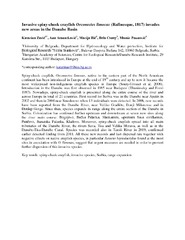Приказ основних података о документу
Invasive spiny-cheek crayfish Orconectes limosus (Rafinesque, 1817) invades new areas in the Danube River Basin in Serbia
| dc.contributor.editor | Trajanovski, Sasho | |
| dc.contributor.editor | Trichkova, Teodora | |
| dc.contributor.editor | Tomov, Rumen | |
| dc.contributor.editor | Vladimirov, Vladimir | |
| dc.contributor.editor | Kalcheva, Hristina | |
| dc.contributor.editor | Zdraveski, Konstantin | |
| dc.creator | Zorić, Katarina | |
| dc.creator | Atanacković, Ana | |
| dc.creator | Ilić, Marija | |
| dc.creator | Csanyi, Bela | |
| dc.creator | Paunović, Momir | |
| dc.date.accessioned | 2019-09-18T11:34:16Z | |
| dc.date.available | 2019-09-18T11:34:16Z | |
| dc.date.issued | 2019 | |
| dc.identifier.issn | 1409-9373 | |
| dc.identifier.uri | https://radar.ibiss.bg.ac.rs/handle/123456789/3465 | |
| dc.identifier.uri | http://esenias.org/files/9_ESENIASDIAS_Book_of_abstracts-5WEB.pdf | |
| dc.description.abstract | Spiny-cheek crayfish, Orconectes limosus, native to the eastern part of the North American continent has been introduced in Europe at the end of 19th century and up to now it became the most widespread non-indigenous crayfish species in Europe (Souty-Grosset et al. 2006). Introduction in the Danube was first observed in 1985 near Budapest (Thuránszky and Forró 1987). Nowadays, spiny-cheek crayfish is presented along the entire course of the river and across Europe in total of 21 countries. First record for Serbia was in the Danube near Apatin in 2002 and then in 2004 near Smederevo when 13 individuals were detected. In 2008, new records have been reported from the Danube River, near Veliko Gradište, Donji Milanovac and in Đerdap Gorge. Since than, species expands its range along the entire section of the Danube in Serbia. Colonization has continued further upstream and downstream at seven new sites along the river main course: Bogojevo, Bačka Palanka, Slankamen, upstream Sava confluence, Pančevo, Banatska Palanka, Kladovo. Moreover, spiny-cheek crayfish spread into all main tributaries of the Danube River, the rivers Sava, Tisa and Velika Morava, as well as in the Danube-Tisa-Danube Canal. Species was recorded also in Tamiš River in 2019, confirmed earlier detected finding from 2011. All these new records and fast dispersal rate together with negative effects on native crayfish species, in particular Astacus leptodactylus found at the most sites in association with O. limosus, suggest that urgent measures are needed in order to prevent further dispersion of this invasive species. | en |
| dc.language.iso | en | sr |
| dc.publisher | Ohrid, PSI Hydrobilogical Institute Ohrid (HIO) | sr |
| dc.rights | openAccess | sr |
| dc.rights.uri | https://creativecommons.org/licenses/by-nc-nd/4.0/ | |
| dc.source | Book of Abstracts. Species, ecosystems and areas of conservation concern under threat from the invasive alien species; Joint ESENIAS and DIAS Scientific Conference and 9th ESENIAS Workshop. Ohrid, Republic of North Macedonia; 2019 Sep 3-6. | sr |
| dc.subject | Spiny-cheek crayfish | sr |
| dc.subject | Invasive species | sr |
| dc.subject | Serbia | sr |
| dc.subject | Range expansion | sr |
| dc.title | Invasive spiny-cheek crayfish Orconectes limosus (Rafinesque, 1817) invades new areas in the Danube River Basin in Serbia | en |
| dc.type | conferenceObject | sr |
| dc.rights.license | ARR | sr |
| dcterms.abstract | Зорић, Катарина; Aтанацковић, Aна; Цсанyи, Бела; Илић, Марија; Пауновић, Момир; | |
| dc.rights.holder | © 2019 by the PSI Hydrobilogical Institute Ohrid (HIO) | sr |
| dc.description.other | Trajanovski S, Trichkova T, Tomov R, Vladimirov V, Kalcheva H, Zdraveski K, editors. Book of Abstracts. Species, ecosystems and areas of conservation concern under threat from the invasive alien species; Joint ESENIAS and DIAS Scientific Conference and 9th ESENIAS Workshop; 2019 Sep 3-6; Ohrid Republic of North Macedonia. Ohrid: PSI Hydrobilogical Institute Ohrid (HIO); 2019. p. 111. | |
| dc.citation.vancouver | Zorić K, Atanacković A, Ilić M, Csanyi B, PaunovićM. Invasive spiny-cheek crayfish Orconectes limosus (Rafinesque,1817) invades new areas in the Danube River Basinin Serbia [abstract]. In: Trajanovski S, Trichkova T, Tomov R, Vladimirov V, Kalcheva H, Zdraveski K, editors. Book of Abstracts. Species, ecosystems and areas of conservation concern under threat from the invasive alien species; Joint ESENIAS and DIAS Scientific Conference and 9th ESENIAS Workshop. Ohrid, Republic of North Macedonia; 2019 Sep 3-6. Ohrid: University “St. Kliment Ohridski” Bitola, PSI Hydrobiological Institute Ohrid; 2019. p. 111. (Station hydrobiologique; Vol. 44; No. 1) | |
| dc.citation.spage | 111 | |
| dc.type.version | publishedVersion | sr |
| dc.identifier.fulltext | https://radar.ibiss.bg.ac.rs/bitstream/id/5388/bitstream_5388.pdf | |
| dc.identifier.rcub | https://hdl.handle.net/21.15107/rcub_ibiss_3465 |

